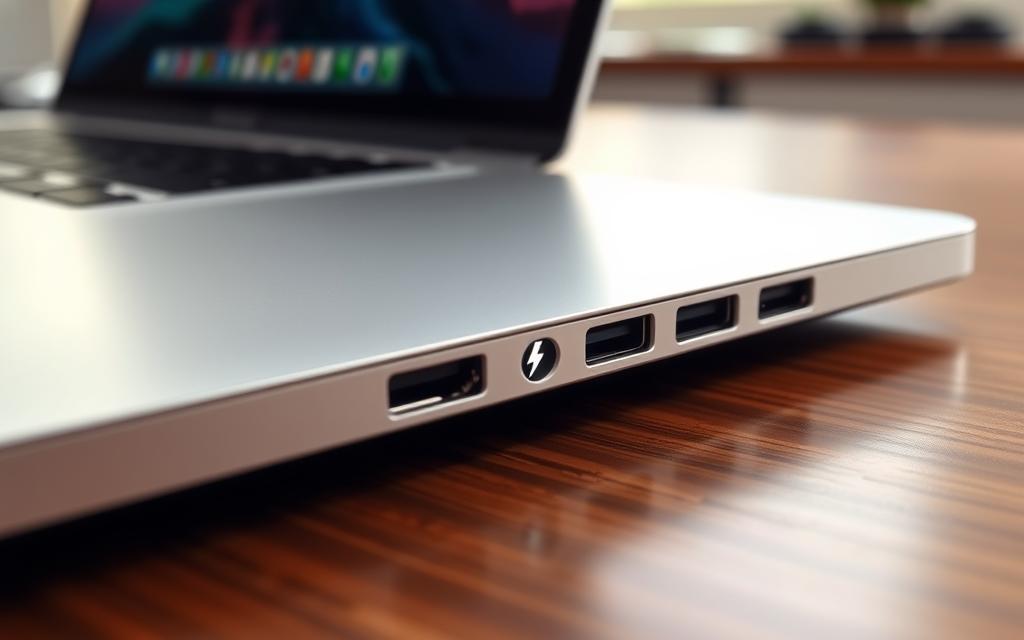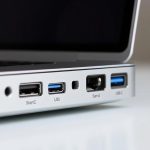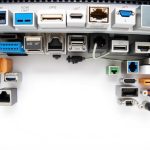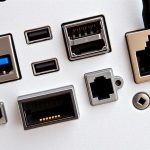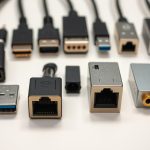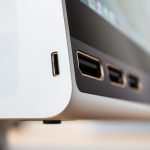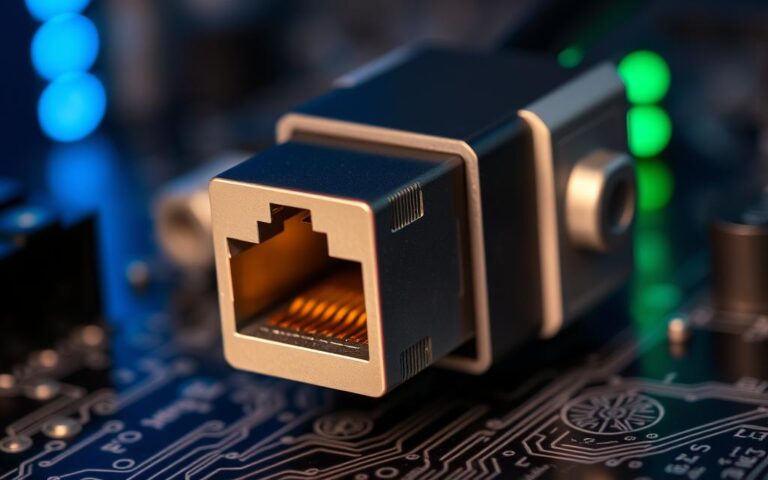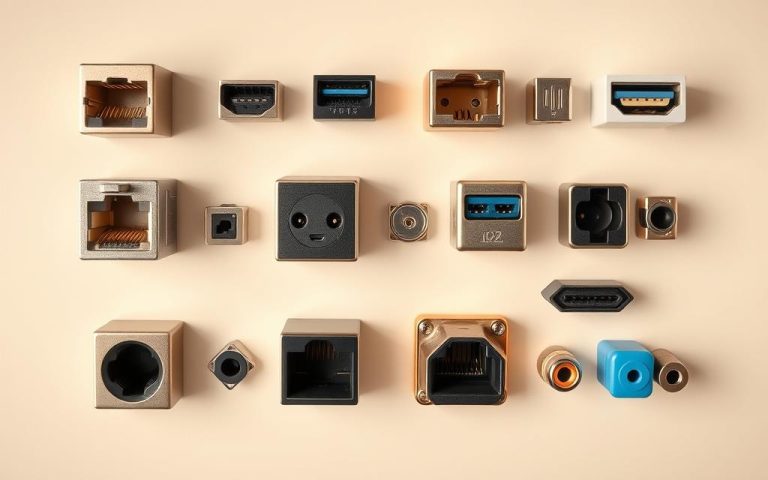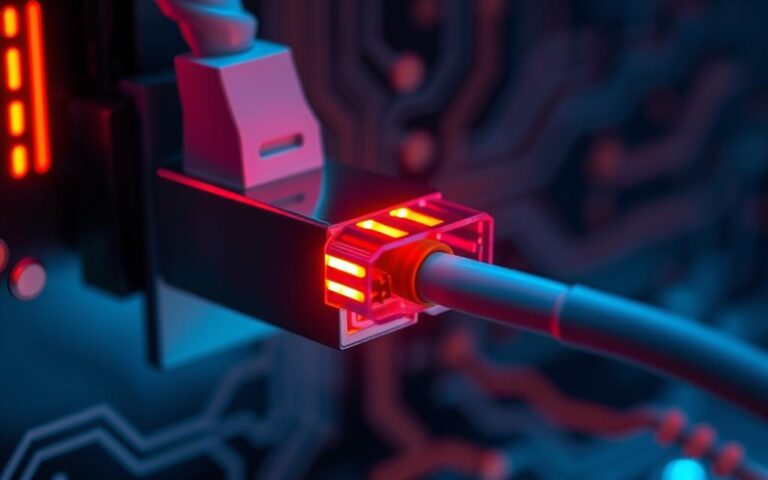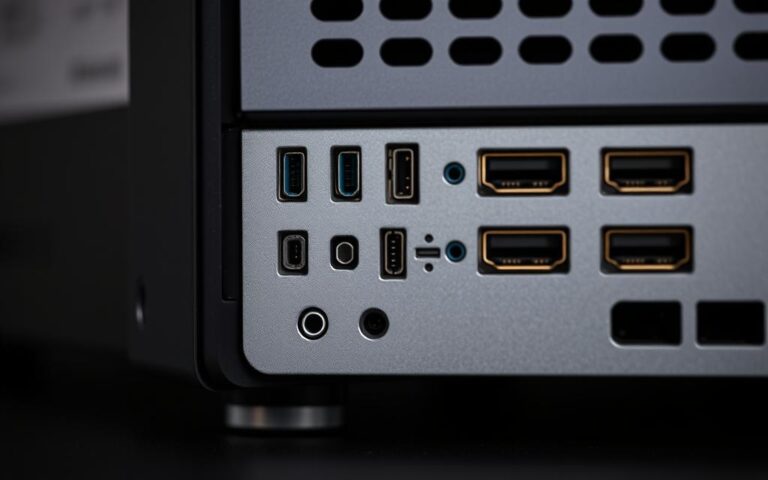How to Check if Your Computer Has a Thunderbolt Port
Today, being able to check for a Thunderbolt port is key for a better computing experience. Thunderbolt technology offers fast data transfer and easy connection with various devices. It’s great for both everyday and professional use. If you’re asking yourself, “Does my computer support Thunderbolt?” this guide is for you. You’ll learn how to spot Thunderbolt ports and why they matter.
Lately, laptop advances mean newer Mac models, like the MacBook Air and iMac from 2020 on, come with Thunderbolt/USB 4. Some have Thunderbolt 3. Knowing your Thunderbolt port type boosts your device’s functionality and compatibility with new hardware. Let’s explore how to find Thunderbolt ports on your device.
Understanding Thunderbolt Technology
To understand modern connectivity, we must explore Thunderbolt technology. This interface changed how we transfer data, display video, and power devices with just one connector. Thunderbolt has grown a lot since 2011, making it more useful in many jobs.
What is Thunderbolt?
Thunderbolt technology allows data transfers at amazing speeds, up to 40 Gbps with Thunderbolt 3. It lets you connect many devices together easily, reducing the mess of cables. It also supports high-quality displays and provides up to 100W of power to devices. For more about Thunderbolt, see this resource.
Differences Between Thunderbolt Versions
Each version of Thunderbolt brought its own improvements. Thunderbolt 1 could transfer data at 10 Gbps. Thunderbolt 2 increased this to 20 Gbps. Thunderbolt 3 and 4 kept the speed at 40 Gbps but added better support for devices and power supply. Thunderbolt 3 uses a USB-C connector and can charge laptops with up to 85W. Thunderbolt 4 further improves this by offering more bandwidth for certain drives.
| Thunderbolt Version | Max Data Transfer Speed | Power Delivery | Display Support | Released |
|---|---|---|---|---|
| Thunderbolt 1 | 10 Gbps | N/A | 1 x 4K | 2011 |
| Thunderbolt 2 | 20 Gbps | N/A | 1 x 4K | 2013 |
| Thunderbolt 3 | 40 Gbps | Up to 100W | Dual 4K or 1 x 5K | 2015 |
| Thunderbolt 4 | 40 Gbps | Up to 100W | Dual 4K | 2020 |
| Thunderbolt 5 | Expected 80 Gbps | N/A | To be announced | 2023 |
Identifying Thunderbolt Ports on Your Computer
Finding Thunderbolt ports on your computer is key for better connectivity and performance. It helps to know Thunderbolt ports by their look, setting them apart from USB ports. It’s important to recognise their features and symbols.
Physical Characteristics of Thunderbolt Ports
Thunderbolt ports look sleek and are often similar to USB-C connectors. They are found on newer devices, like Macs from 2021 onwards. For instance, the 14-inch and 16-inch MacBook Pros and the Mac mini have them. These ports transfer data faster and can do more than standard USB ports.
- Lightning bolt icon: A definitive indicator of Thunderbolt capability.
- USB-C shape: Ensures compatibility with various accessories and displays.
- Enhanced power delivery: Allows devices to charge while simultaneously transferring data.
Recognising Thunderbolt Icons
Knowing the Thunderbolt icon helps identify these ports. This symbol, a lightning bolt, is easy to spot. Below, we compare Thunderbolt icons with other connectors.
| Port Type | Icon | Connection Features |
|---|---|---|
| Thunderbolt 3 | Up to 40 Gbps, data, video, and power | |
| USB-C | — | Up to 10 Gbps, data and power |
| HDMI | — | Video and audio output |
Getting to know these details makes Thunderbolt ports easy to spot. This helps you make the most of Mac devices’ Thunderbolt tech for better usability and functionality.
Does My Computer Have a Thunderbolt Port?
Many users wonder if their computer has Thunderbolt technology for better data and device connection. To find out, you can check through the Device Manager or use diagnostic tools on a Windows system.
Using Device Manager to Check Thunderbolt Support
Looking in the Device Manager gives insight into Thunderbolt support. To find Thunderbolt devices in Windows, do the following:
- Right-click on the Start menu and select Device Manager.
- Look in the Device Manager window under System Devices.
- Search for anything that says Thunderbolt Controller or Thunderbolt Device.
- If you see those entries, then your computer probably supports Thunderbolt.
If the Device Manager shows Thunderbolt sections, your system is set for fast data transfer and connecting devices.
Running Diagnostic Tools on Windows
Using diagnostic tools, like dxdiag.exe, is another good way to check. This tool checks your hardware and driver status. To use it, here’s what to do:
- Press Win + R to get the Run dialog.
- Type dxdiag and hit Enter.
- In the DirectX Diagnostic Tool, check the Display and System tabs.
- Look for Thunderbolt device details, like device IDs for the Thunderbolt Controller.
By using this method, you get a full picture of your hardware. It ensures your Thunderbolt support in Windows is active and the drivers are working right.
Using Software Tools for Identification
Various software tools can help you find out if your computer supports Thunderbolt. These tools give insights about your hardware. This helps you know if you can use Thunderbolt. We will talk about using dxdiag.exe and some third-party apps for this purpose.
How to Use dxdiag.exe on Windows
The dxdiag.exe tool helps you learn about your system’s hardware on Windows. Here’s how to use it:
- Press the Windows key + R to open the Run dialog.
- Type dxdiag and press Enter. This will open the DirectX Diagnostic Tool.
- Go through the tabs to find information on your graphics and devices.
- Search for “Thunderbolt” or similar hardware entries to confirm support.
This step is good to do before you try other software for finding Thunderbolt support.
Third-Party Applications for Thunderbolt Detection
Third-party Thunderbolt applications can also help in identifying Thunderbolt support. Programs like the Intel Thunderbolt Control Center are useful. They help diagnose compatibility problems or with installing drivers.
You can get the latest Intel TB DCH driver from the Intel site. Keeping your system updated helps use Thunderbolt better. Users share different experiences with apps. They help with things like updating firmware or solving connection problems, especially for devices like the Akitio Node or Aorus Gaming Box.
It’s smart to know about the latest software versions. For example, knowing about Thunderbolt Control Center version 1.4.648.5. Or about driver updates from HP like version 16.3.61.2. Staying updated helps avoid problems like poor connection or system crashes.
For extra help on Thunderbolt support, check out this detailed resource. It covers troubleshooting and general compatibility tips.
Conclusion
Knowing about Thunderbolt ports helps improve your computer use. This article explained how to find out if your computer has Thunderbolt. It told you about looking at the port’s shape and using software to check. It also talked about different Thunderbolt types and some computers that don’t support Thunderbolt.
Being able to check for Thunderbolt ports is key for people needing fast connections. This is important for tasks like using 4K screens or external graphics cards. Thunderbolt 3 brings benefits over older versions. So, it’s important to stay up-to-date with this tech.
In short, knowing about Thunderbolt 3 and the limits of USB-C ports without Thunderbolt is crucial. This guide helps you find your way around Thunderbolt. This ensures you get the most from your computer and devices.
FAQ
How can I check if my computer has a Thunderbolt port?
Look for the lightning bolt icon on your computer’s port. You can also use the Device Manager in Windows. It shows if Thunderbolt devices are listed under system devices.
What are the key features of Thunderbolt technology?
Thunderbolt enables fast data transfers, video output, and power delivery. There are versions from Thunderbolt 1 to 4. Each has different speeds and compatibility.
How do I differentiate between Thunderbolt and USB ports?
Thunderbolt ports have a lightning bolt icon and use USB-C connectors. USB ports differ in shape and size. This helps tell them apart from Thunderbolt ports.
Can I use built-in tools to verify my computer’s Thunderbolt support?
Yes, tools like Device Manager on Windows can confirm Thunderbolt support. The dxdiag.exe tool checks for Thunderbolt in hardware and drivers.
What software can I use to identify Thunderbolt capabilities on my computer?
The dxdiag.exe tool on Windows helps. It looks for Thunderbolt-related info. Also, some third-party apps can detect Thunderbolt capabilities.
Why is it important to identify Thunderbolt ports and technology?
Knowing about Thunderbolt ports lets you use fast data transfer and connectivity. It improves your experience with compatible devices and peripherals.

